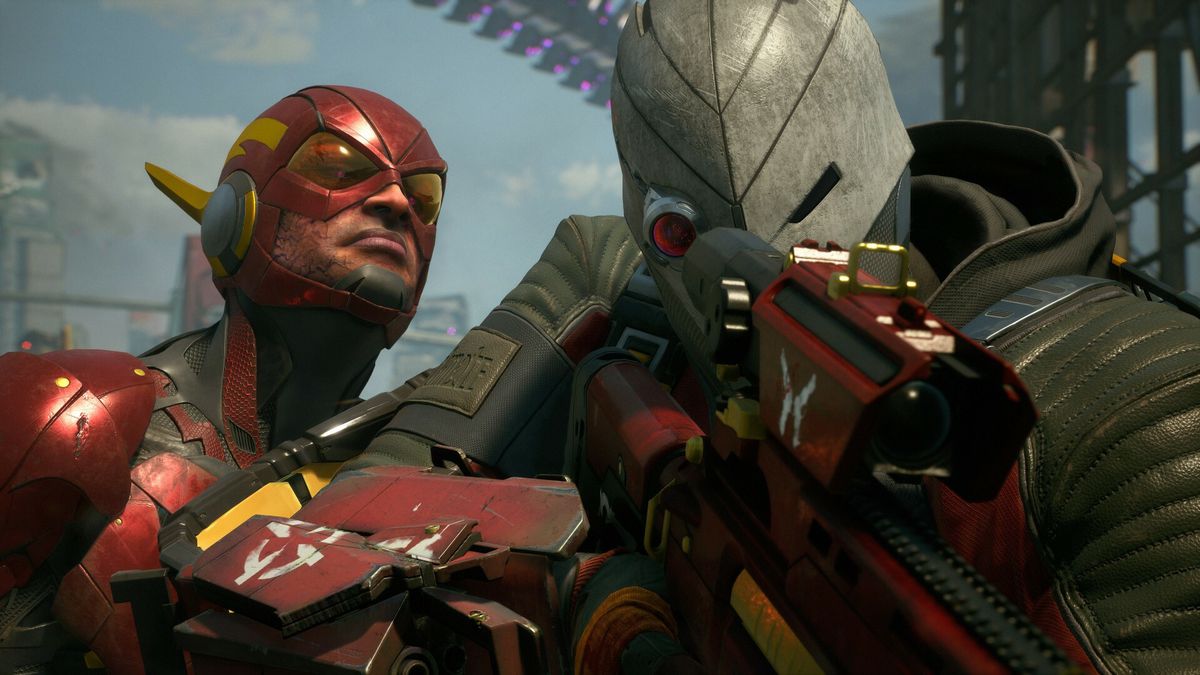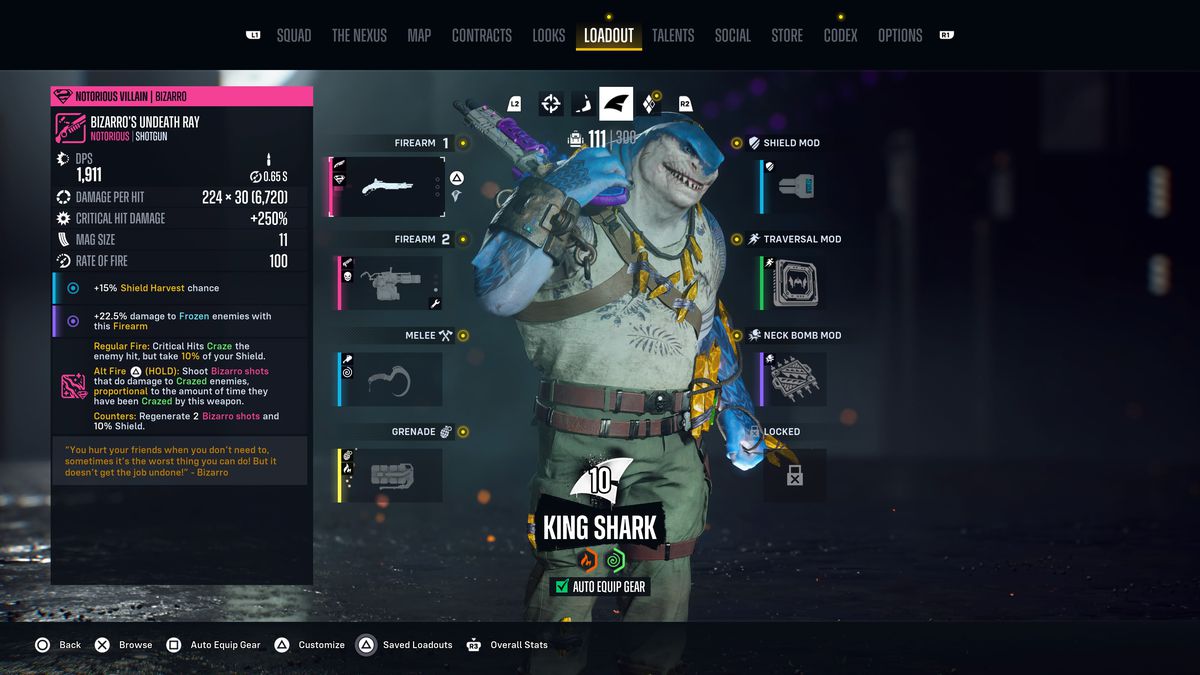Suicide Squad: Kill the Justice League should have been more fun
The developers of the beloved Batman Arkham games have a new DC game, this time told from the villains’ perspective. But what should feel like a fresh start for Rocksteady Studios instead feels like a misstep: a game full of tired mechanics and bad jokes.
Suicide Squad: Kill the Justice League is a third-person shooter that expands Rocksteady’s Batman Arkhamverse from Gotham City to Metropolis, home of Superman and the Justice League. The alien supervillain Brainiac has invaded Earth, controlling most of the Justice League and enslaving the citizens of Metropolis as part of his plan to build a new version of his home planet.
Faced with a team of superheroes turned supervillains, government agent Amanda Waller enlists a quartet of criminal misfits – Captain Boomerang, Deadshot, Harley Quinn and King Shark – for Task Force fear that it will explode. little bombs in their heads. This Suicide Squad will have to use unconventional methods to take down the League and its master.
So three regular people and a not-so-smart shark guy don’t seem like a good match for the likes of Superman and Green Lantern Suicide Squad: Kill the Justice League equip the crew with weapons and deadly gadgets that provide the members with borrowed superpowers. This concept is relatively easy to swallow, until you come face to face with the sometimes god-like members of the League.
You always play as a team Kill the Justice League, either with friends in online multiplayer, or with three bots. You can switch between characters whenever you want, but the game recommends switching between certain team members at certain times, mainly to give you some variety and add a little extra narrative heft to encounters.
Image: Rocksteady Studios/Warner Bros. Games via Polygon
Suicide Squad: Kill the Justice League also has a strong emphasis on traversal mechanics. Each member of Task Force King Shark can leap tall buildings in a single bound, making him the easiest to control. Deadshot has a simple, beginner-friendly jetpack. Captain Boomerang picks up a Speed Force gauntlet, which allows him to sprint at ground level and sort of teleport. (“Boomer,” as his squadmates call him, has easily the strangest ways of getting around.) Harley can swing through Metropolis in a way that combines Batman’s flying and Spider-Man’s swinging, but it feels frustratingly clumsier than combining those two great -sensing video game locomotion methods should do that.
Moving through Metropolis feels good most of the time, which is a good thing because you spend a lot of the game climbing buildings and jumping across rooftops between missions. Shooting, your main way of taking down enemies, also feels good on a basic level.
However, Rocksteady piles on a huge list of skills beyond just shooting guns, and they range from insignificant to overly complicated. You can defeat bad guys to recharge your shield; counterattack enemies ready to attack you; powerslide to knock over enemies; and so on and so forth. There’s a huge range of weapons, grenades, melee weapons and elemental modifiers for every type of weapon, making battles visually and mechanically chaotic, overwhelming the screen with effects and damage numbers. Suicide Squad: Kill the Justice League piles on too many mechanics, some of which aren’t necessary to actually win battles – that is, until the game forces you to use them. In some of The suicide squad On the most frustrating missions, certain enemies will only take damage from critical hits, or after you acquire a resource that depletes over time. These combat tweaks transform already repetitive missions into a slog with difficulty spikes that don’t feel additive, just annoying.
Most of the enemies you fight in the city are mutated Metropolitans and Braniac-driven vehicles. None of them are particularly interesting to fight; Often you’re just looking for a purple pimple until something explodes.

Image: Rocksteady Studios/Warner Bros. Games
When you come face to face with members of the Justice League, things take a turn for the worse. Characters like Flash, Green Lantern, and Superman, who at other times are shown to have god-like abilities, inexplicably toy with Task Force X in lengthy, gimmick-laden battles. Boss battles are full of spectacle, but also tedious and frustrating: League members rush across the screen in ways that are difficult to follow and clog arenas with environmental attacks that can chug the frame rate.
Both the side missions and the main narrative quests are also painfully repetitive. They involve standing by a truck and shooting things. Or walking past a moving truck and shooting things. Or stand near one of the Poison Ivy plants and shooting equipment. Sometimes you’ll be asked to rescue civilians or soldiers trapped behind enemy lines, and that means frantically shooting things until the mission unceremoniously ends.
Suicide Squad: Kill the Justice League is a looter shooter of sorts, so after the mission you’ll get a handful of rewards, including new weapons from arms dealer Penguin, a variety of currency and materials (which you can trade in for new weapons or weapon modifiers), and some XP. You’ll slowly upgrade a series of skills and abilities that don’t seem to have any noticeable impact on your performance amid the storm of explosions and damage numbers flying across the screen.
You also get random equipment after completing a task. You can also craft equipment using the various currencies you collect in Metropolis. Unfortunately, these weapons, shields and other bits of technology rarely feel impactful. There are so many modifiers and stats to decipher that I ended up just looking at the green arrows pointing up (better!) and the red arrows pointing down (worse?) to decide if I should equip something or not. Eventually I started to understand some of the game’s extensive jargon, but it didn’t have much impact on my behavior in battle or when choosing my equipment.

Image: Rocksteady Studios/Warner Bros. Games via Polygon
While missions are mostly boring, there’s a pretty entertaining story at its core Kill the Justice League. The members of Task Force Waller, played viciously by the great Debra Wilson, is a believably cruel taskmaster who constantly threatens the team, which feels tonally appropriate since if she doesn’t, everyone will die anyway. And the possessed members of the Justice League come off as total bastards, their identities foregrounded by Brainiac’s mind manipulations.
Fans of Rocksteady’s Arkham games, and especially its Batman version, may find the game’s cruelty and cynicism hard to stomach. The game’s title pays off – yes, you kill the Justice League, often in ways that feel dismissive of people’s fondness for these iconic characters. Almost everything is treated as a joke and only a handful of jokes land. The rest – attempts at humor, yes unrelenting – are endlessly unfunny. At one point, a member of Task Force After completing the game’s story, I’m glad I finished listening to these characters.
Which is perhaps the most surprising Suicide Squad: Kill the Justice League is how much love, attention and years of work have gone into it. Yet it is such a mediocre experience. There are moments of great storytelling here, and strong performances to back it up. Metropolis is a fantastic city, full of brightness and charm that Rocksteady’s Gotham lacked. And the characters, especially their faces, look beautiful. The expressive animation of characters like Harley Quinn and King Shark makes these characters feel believable and sometimes even sympathetic.
But the repetitive mission design, terrible humor and lackluster loot mechanics drag down what should have been a fun inversion of the dark Batman Arkham games. Suicide Squad: Kill the Justice League feels like a second round of closure for Rocksteady in the DC universe – but instead of the satisfying and hopeful ending of Batman: Arkham Knightit ends the story with a deafening bullet to the head.
Suicide Squad: Kill the Justice League was released on February 2 on PlayStation 5, Windows PC and Xbox Series X. The game was reviewed on PS5 using a pre-release download code from Warner Bros. Games. Vox Media has affiliate partnerships. These do not influence editorial content, although Vox Media may earn commissions on products purchased through affiliate links. You can find Additional information about Polygon’s ethics policy can be found here.
